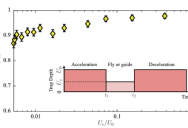How Scientists Turned Atoms Into Tiny Baseballs And Played Catch With Light
by Jen Sako

Scientists have discovered the tiniest and quirkiest game of baseball in the atomic world, and it’s a hit!
Using a fancy technique called optical trapping, they’ve mastered the art of catching and throwing individual atoms. It’s like watching the world’s smallest pitcher and catcher duo in action.
Picture this: scientists with highly focused lasers, essentially their atomic tweezers, throwing around chilled rubidium atoms like a pro pitcher. They even used lasers to create a makeshift baseball glove, another optical trap, to catch these atomic baseballs on the fly.

As detailed in a new study published in the journal Optica, in the world’s smallest ballpark, the rubidium atoms zipped through the air for a grand total of 4.2 micrometers at a whopping speed of a little over 25 inches per second. It’s not quite the fastball you’d see in a regular baseball game, but in the atomic realm, it’s a massive leap.
“The freely flying atoms move from one place to the other without being held by or interacting with the optical trap,” said study co-author Jaewook Ahn, a physicist at the Korea Advanced Institute of Science and Technology, in a press release.
“In other words, the atom is thrown and caught between the two optical traps much like the ball travels between the pitcher and a catcher in a baseball game.”

Now, why is this atom-tossing spectacle a big deal? Well, it might just be the ticket to supercharged quantum computers. You see, these flying atoms could revolutionize quantum computing by letting us shuffle quantum bits (qubits) around more freely.
“These types of flying atoms could enable a new type of dynamic quantum computing by allowing the relative locations of qubits — the quantum equivalent to binary bits — to be more freely changed,” Ahn explained.
Imagine packing neutral atoms like rubidium into super tight arrays, which could potentially give us way more qubits than traditional silicon-based setups. Plus, these free-flying atoms seem pretty unfazed by their journey, making this experiment a potential home run for quantum computing.
So, in the atomic world, scientists are playing catch and throw, and who knows, maybe the next World Series will be in the quantum realm!

Sign up to get our BEST stories of the week straight to your inbox.




